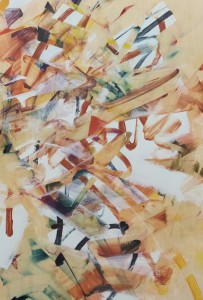“STRIDES by strokes”
Shingo Tanaka Solo Exhibition
2023.07.01(sat.)— 07.30(sun.)
open on fri., sat., and sun. 12:00-18:00
appointments are available on weekdays
free admission
.
In July 2023, eN arts will hold Shingo Tanaka’s solo exhibition “STRIDES by strokes”. Fascinated by fire and flame, Tanaka has been making works employing the phenomena of combustion since he was a student at Kyoto Seika University. In 2008, he first presented the series “trans”, with works created employing a combustion process in which he burned many layers of white paper that caused each sheet to burn and wrinkle up as ashes. Since then, he has developed a number of new series, including “re:trans”, which uses waste materials, “meltrans”, which melts metals and plastics with heat, and “ephemeral”, which captures the soot rising from a burning flame in order to capture the moment. (You can view these series at https://shingotanaka.net/work-menu/). Tanaka, continuing to create works using “fire” as a theme in this exhibition, examines the phenomenon when “fire” extinguishes matter and the phenomenon that heat causes matter to change via painting. The strokes drawn with the brush, the strokes that erase the drawn things, and the way each stroke progresses the work are together an abstract expression of “fire”.
Naomi Rowe | eN arts
.
STRIDES by strokes
I mainly have been creating artworks that incorporate the act of combustion. Burning causes substances to lose their mass as they combust or dissolve. For me, using fire is a way of thinking about how to deal with materials that are being lost.
In this series, I attempt to replace the method of creating works from the loss by combustion to loss (or disappearance) via the process of painting. The object of disappearance in this method is the paint on the screen. I attempt to consider the act of ‘erasing’, which usually means correcting, as the same as the act of ‘painting’. The technique involves repeatedly drawing lines with oil paint on a panel, with a varnished surface, and then wiping them off. Initially a series of tasks with a strong awareness of ‘erasing’, but as the work is repeated, the act of ‘erasing’ gradually overlaps with ‘drawing’. This may be because my awareness of trying to paint makes me decide each time what to leave behind in the act of wiping. Additionally, it is also due to the richness of the strokes. The blurring, smearing, dripping, pooling, staining, blurring, smudging, peeling, dullness and murkiness that result from erasure become noise and build up on the screen. I have difficulty recalling the state of each noise before I erased it, but the whole of it will influence my next decision.
‘Drawing’ and ‘erasing’ are equally one stroke in the composition of a painting, and there is no need to distinguish between them in the first place. Nevertheless, I would still like to see how the noise created by the process of loss of presence affects our vision.
Shingo Tanaka
.
-WORKS-
-INSTALLATION VIEW-

